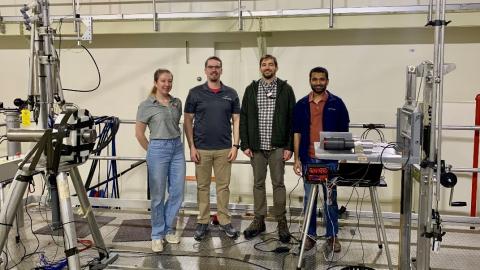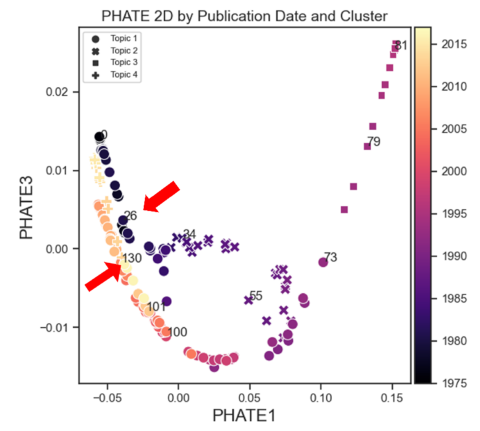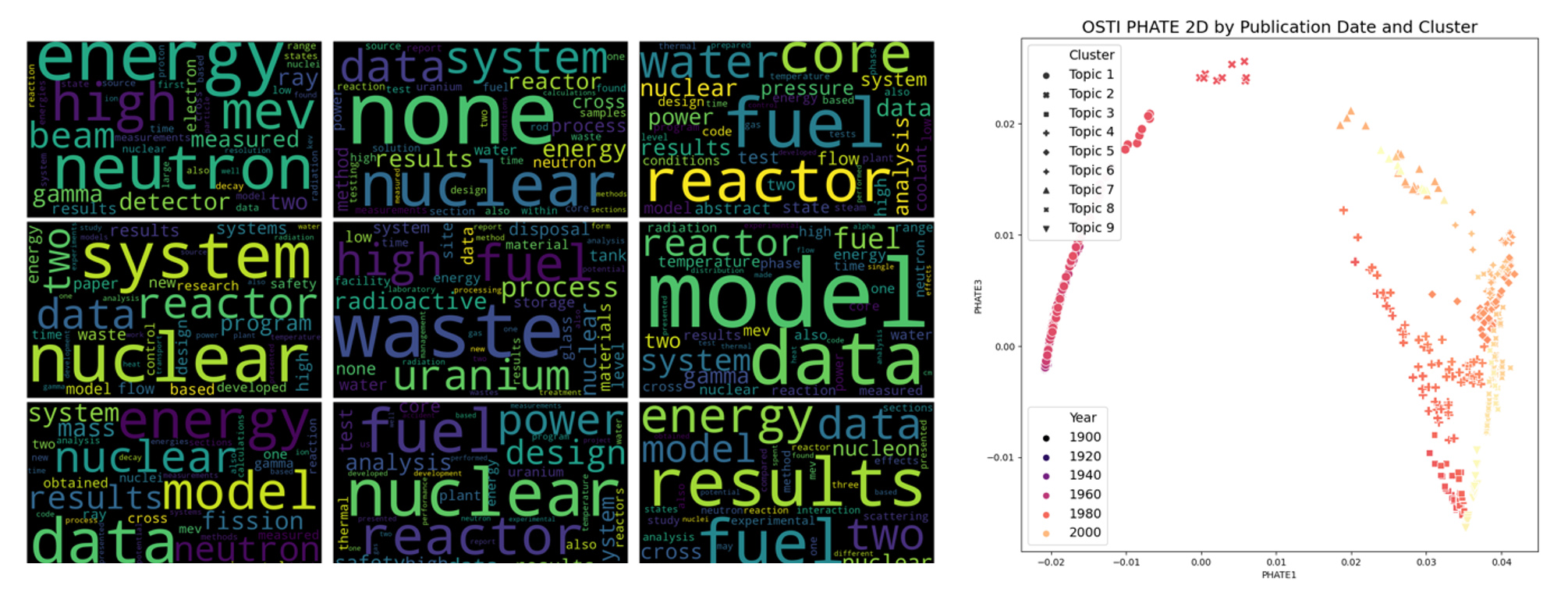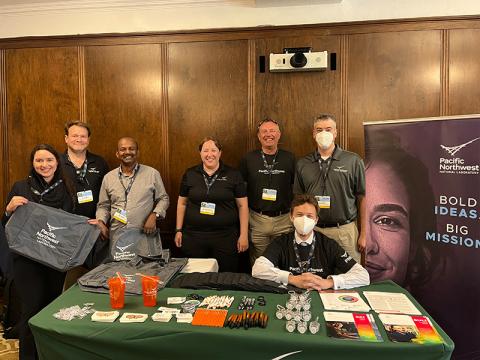Highlights
Improving Arms Control Verification
PNNL researchers collaborated with a team from the Massachusetts Institute of Technology (MIT) to evaluate an electronic cryptography data acquisition (DAQ) system. PNNL experts provided background and context relevant to arms control verification measurements, sharing recommendations with the goal of expanding the system's capabilities. The teams utilized the newly developed DAQ to acquire and analyze neutron resonance transmission data on relevant special nuclear material (SNM) targets, which informed discussions on measurement needs and improvements to DAQ functionality.
Enabling Technology and Innovation 2.0
- PNNL’s Dr. Vered Shaffer, nuclear engineer, presented a talk to the ETI 2.0 Cross Cutting Seminar, titled "Why Am I Being Regulated? The History and Context of Nuclear Regulations." The
talk provided a brief look at the nuclear regulatory history for the U.S. Nuclear Regulatory
Commission and the Department of Energy.
Nuclear Forensics
- The University of Florida (lead) hosted the 2025 University Program Review the first week of
June. The review is the annual gathering of all NA22 consortia enabling students to share their
research and network with one another.
Monitoring, Technology, and Verification
- PNNL hosted Jill Rahon, a Massachusetts Institute of Technology (MIT) graduate student’ to collect experimental measurements for his research. As shown in the picture, a Thermo Scientific P 385 Neutron Generator is on the left with a moderator/multiplier assembly, and detectors are on the right with 2.0-meter standoff from the source. First-of-a-kind Neutron Resonance Capture Analysis (NRCA) measurements of Uranium-233 and other materials were made to demonstrate NRCA as a possible future method for thorium fuel cycle safeguards.

Other Highlights
- Although PNNL is not a formal member of the Nuclear Science and Security Consortium (NSSC), PNNL researchers have collaborated with and supported several students on research connected with this consortium this past year.
Past Highlights
- PNNL is heavily engaged with Consortium for Nuclear Forensics (CNF) leadership as well as several universities and students through involvement across many projects. This includes supporting Nic Kemper, a Ph.D. graduate student from Penn State, who is working at PNNL this summer on development of a segmented Compton suppressed charged particle coincidence counter. Another graduate student, Hannah Patz from the University of Florida, is also working at PNNL this summer to develop autoradiography methods for rapid post-detonation particulate identification
- In nuclear nonproliferation, models of author behavior critically reveal how information sharing and information propagation occur within the nuclear science community.
Conrad Hougen of the University of Michigan (UM) combined the Geometry-Driven Longitudinal Topic Model (GDLTM), a longitudinal document-topic model, with related author-topic models, to create a novel approach to the problem of co-authorship prediction. He worked with Dr. Alfred Hero, UM, and PNNL’s Dr. Karl Pazdernik. Their approach identifies the benefits of using dynamic topic modeling to forecast author behavior, providing a richer interpretation than standard methods in bibliographic link prediction. Specifically, their model predicts the existence and topic of unobserved author collaborations, while generating visualizations of topic trajectories, doing so in a way that scales to the size of massive scientific collaboration networks. This methodology has also been shown to improve link prediction over comparable network-only approaches.
As an example of the GDLTM component of co-authorship prediction, this illustration shows the evolution of scientific literature marked as “Deep Learning” from 1975 to 2018. The left plot shows the results of a low-dimensional embedding of topic vectors, filtered down by articles within the field of “Deep Learning” and discovered year by year from 1975 to 2018. These points are color-coded based on the year of the publications that make up these topics, while the shapes of the points in the diagram are the global topics that each point belongs to, based on a clustering approach. The low-dimensional embedding is generated by a method known as PHATE, which results in points that trend in specific directions over time, rather than simply grouping related points near each other in the two-dimensional visualization.

- PNNL staff participated in the 2024 University Program Review held at Texas A&M University in June 2024.
- Textual data, such as nuclear science manuscripts, contains information that can enable nuclear proliferation detection. Topic modeling is a technique within natural language processing that can be applied to this type of corpus to understand active areas of research. However, given the dynamic nature of scientific literature, a dynamic approach is needed to automatically model emerging trends and detect anomalies in high-volume streaming data. To this end, we have developed a scalable tool based on dynamic topic models and computational geometry for visualizing trends and anomalies. This work modified a prior model, which was demonstrated on Twitter data, for use on Office of Scientific and Technical Information scientific abstract data. Illustrations from this analysis are provided in Figure 1. On the left, we depict word clouds for the nine topics identified during the period 1940–2020. On the right, the 2-dimensional similarity between topics is measured by Potential of Heat-diffusion for Affinity-based Transition Embedding dimension reduction and colored by year. As seen in this figure, topic one evolves significantly more than other topics over the 80 years.

- As an additional highlight, PNNL also worked with Enabling Technology and Innovation (ETI) colleagues to help build out and deliver the curriculum for “ETI 101 - Fundamentals of Nuclear Science and Engineering for Nonproliferation.” In particular, PNNL completed the organization and content for “ETI 101 Module 4 - Overview of Nuclear Security and Nonproliferation” which featured a live “tour” of PNNL’s Shallow Underground Laboratory for Trace Detection by Emily Mace. Also, PNNL’s Sarah Frazer helped to organize a new set of topics for “ETI 101 Module 5 - Nexus of Technology and Policy” which featured two different lectures by staff at PNNL – “History and Development of Nonproliferation System” by Robert Marek and “International Treaty Context of Nonproliferation and Arms Control” by Kate Doty.
- PNNL participants joined the 2022 NNSA University Program Review held at the University of Michigan.

- At the 2021 NNSA University Program Review, University of Michigan student Patrick Skrodzki was presented the Best National Laboratory Collaboration Award for MTV in recognition of his collaborative work with PNNL, as presented in Generation and Characterization of Nonproliferation Signatures in Laser-Produced Plasmas at the meeting.